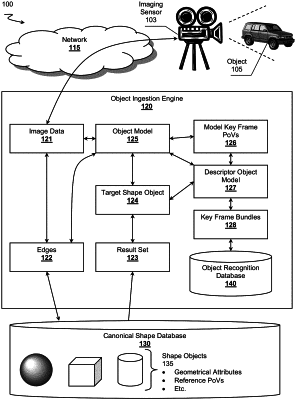| CPC G06V 20/46 (2022.01) [G06F 16/532 (2019.01); G06F 16/5838 (2019.01); G06F 16/5854 (2019.01); G06F 16/5866 (2019.01); G06T 7/13 (2017.01); G06T 7/60 (2013.01); G06V 20/64 (2022.01); G06T 2207/20061 (2013.01); G06T 2207/20116 (2013.01)] | 24 Claims |

|
1. An object recognition and ingestion system, comprising:
at least one non-transitory computer readable memory storing executable object recognition and ingestion software instructions; and
at least one processor coupled with the at least one non-transitory computer readable memory that, upon execution of the object recognition and ingestion software instructions, performs operations to:
obtain a digital representation of a scene, wherein the digital representation is obtained from at least one sensor and further includes image data of at least one three-dimensional object and location information;
obtain a result set of shape objects from a set of one or more candidate shape objects, wherein the result set includes at least one shape object from the set of one or more candidate shape objects and that has at least one shape attribute satisfying selection criteria determined from geometrical information of the at least one three-dimensional object derived from the image data of the at least one three-dimensional object;
select at least one target shape object from the result set of shape objects based on a context and at least one point-of-view associated with the at least one three-dimensional object;
instantiate at least one three-dimensional object model of the at least one three-dimensional object from the at least one target shape object and the image data; and
store, in an object recognition database, a bundle of recognition parameters derived from the object model and location information, wherein the recognition parameters enable a computing device to recognize the at least one three-dimensional object.
|